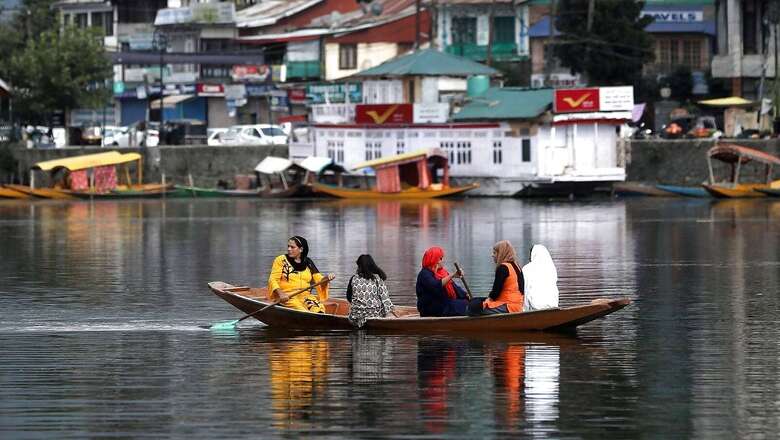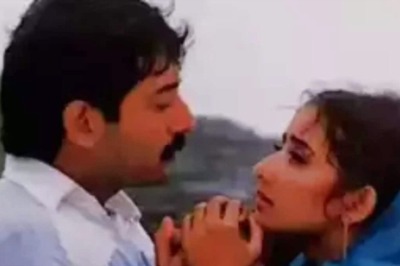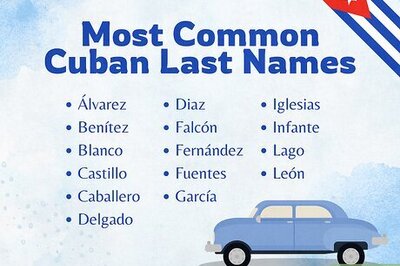
views
On April 9, 1962, a young black man by the name of Roman Ducksworth Jr. was heading to the town of Taylorsville, Mississippi, to see his wife who had just given birth. A white police officer stopped the bus and was enraged to find Ducksworth on board. At the time, blacks in the American deep south were expected to travel in a separate section at the back of the bus. The police officer shot Ducksworth in the chest, killing him on the spot. Such incidents used to be common. In 1967, when a black man in Natchez, Mississippi, was promoted to a position in a rubber and tyre company supposedly reserved for whites, the Ku Klux Klan murdered him by placing a bomb in his truck.
The case of Virendra Paswan is quite similar. He had travelled from Bihar to make a living selling golgappas in Kashmir. Earlier this month, terrorists found him and shot him dead by the side of the street. On October 8, terrorists attacked a school in Srinagar. They lined up the teachers, searched their identity cards to pick out the two of them who happened to be Hindu or Sikh, and shot them dead. The current wave of killings began around end of last year when 65-year-old Satpal Nischal was murdered. His crime? He had acquired for himself a domicile certificate after the abrogation of Article 370.
There are obvious parallels between the current situation in Kashmir and the racist violence in the American south at the time of desegregation. The south fought a war of secession from the United States over slavery, but lost. While slavery was abolished, they kept its spirit alive by severely limiting the rights of blacks for nearly a century. These were the infamous ‘Jim Crow’ laws. They mandated racial segregation, keeping black people out of white spaces everywhere, from schools, colleges and universities to buses and swimming pools. In the 1950s, when the US Supreme Court began striking down these laws, there was widespread resistance. There were riots over black students trying to enroll in white colleges, black people moving into white neighbourhoods or simply trying to ride at the front of the bus. These troubles lasted for nearly twenty years. Southern governors swore to resist. Segregation now, segregation tomorrow, segregation forever, they declared.
Jim Crow Laws and Article 370
Sounds familiar? That is because the so-called Gupkar alliance of leaders from Jammu and Kashmir has a very similar demand. Because Article 370 was India’s version of Jim Crow laws. It was an apartheid law that allowed the state of Jammu and Kashmir to discriminate against women, tribals and any other Indian deemed to be from a “non-native” background. Even the Gorkhas who had lived in the region for a hundred and fifty years, were not spared. Even members of the Valmiki community from Punjab, who moved there on invitation from the state government, as well as their descendants were treated as outsiders with no rights.
ALSO READ | India’s Counterattack After Targeted Minority Killings in J&K Will Further Frustrate Pakistan
Whose interests did the apartheid regime of Article 370 actually serve? It preserved the virtual monarchy of the Abdullahs and the Muftis, the two leading dynasties in the Valley. And, the interests of the rest of the ruling class consisting of their friends, relatives and close associates. Do not forget that there is a racial element to all this. The leaders of the Kashmir valley are Ashraf or upper caste Muslims. The Ashrafs have descended from the Persian and Turkic conquerors who came to India in the 11th and 12th centuries, as opposed to local converts or Pasmanda Muslims, who are treated as lower castes. In the politics of Kashmir where these leaders make a big deal out of who is an insider and who is an outsider, this is a hidden, deeply ironic and deeply hypocritical subplot. In fact, until the abrogation of Article 370, the only state languages in Jammu and Kashmir were English and Urdu. The local Kashmiri and Dogra languages were added to the list only last year through an act passed by the Narendra Modi government.
While the leaders of the Valley have issued “ex-officio” statements against the killing of “outsiders,” they have not condemned the underlying sentiment that drove these killings. You could say that they even pandered to these sentiments, subtly or otherwise, by accusing Indian security forces of committing equally heinous acts of murder. In fact, they have been raising the political pitch against outsiders for decades now, and even more aggressively in the last two years. Again, there are obvious parallels with southern state governors in America in the 1960s, who vowed that blacks would never be allowed to share public space with whites. Their excuses are also disturbingly similar. States’ rights, they say. In both cases, it is bigotry and dehumanization of the other, cunningly packaged as part of the right to self-determination.
What is Kashmiriyat?
This brings us to an issue that we must acknowledge, however prickly it may be. The leaders of the Kashmir valley are not just speaking their own minds on Article 370 and the revenge killings of outsiders. They are also veterans of electoral politics. When they speak, they are also tapping into popular sentiment. In other words, this sentiment exists, and it is very real. Just like the racist white majority sentiment that used to dominate the southern United States.
What is Kashmiriyat and what place does it have in our modern democratic India? Like every other other group of people in our country, the people of Kashmir have a right to be proud of their cultural identity and their history, and they justifiably are. But if cultural pride turns into supremacism, if it leads to prejudice, hatred and violent reprisals against others, then something has gone badly wrong. It is not enough to condemn the violence. One must look within. The onus is on the society itself to rescue its cultural pride by flushing out any build up of hatred. The principle would be the same if it were applied to any other part of India, whether Bengal or Uttar Pradesh or Maharashtra.
As India modernizes and integrates more, there are anxieties about cultural identity everywhere. In fact, these anxieties have been playing out right since 1950. There has been violence and bloodshed as well. But it is only in Kashmir that the violence has been on such a scale, and sustained for so long. There are three reasons for this. The first is Pakistan, of course. The second is Article 370, which allowed Jammu and Kashmir to remain an apartheid state right until 2019. This puts them almost seventy years behind the rest of the country. The third reason is that the sense of cultural identity in Kashmir, or Kashmiriyat, has been distorted by Islamism.
This is the reason we have seen ISIS flags in Kashmir. This is why we have seen young Kashmiris look up to Turkey’s Erdogan and Erdogan trying to return the favour by foolishly meddling in our internal affairs. Is Erdogan of Turkey an insider but Virendra Paswan from Bihar an outsider in Kashmir? Of course not. Not even a terrorist would be foolish enough to believe that. The problem is that the so-called Kashmiriyat has been hijacked by Islamism.
The problem is further complicated by the now structural alliance between liberalism and Islamism all over the world. As a result, the obvious parallels between Jim Crow laws in America, apartheid in South Africa and Article 370 in Kashmir are ignored. As the West gets ready for a reckoning against systemic racism, the issue in Kashmir is projected before the world as one of self-determination. Fifty years ago, southern politicians in the US pushing for racist segregation laws would have welcomed this approach. Another hundred years before that, American states which wanted to keep slavery would have welcomed it too.
ALSO READ | This is How India Can Counter Pakistan’s Dangerous Revival Game in Kashmir
Quite perversely, therefore, it is often the liberal media that takes the lead in framing the Kashmir issue as one of self-determination. There was even a video some years ago, showing a prominent member of ‘civil society’ prompting a youth to change his words and say that he was fighting for Kashmir, instead of fighting in the name of religion. Since then, Islamists have matured in this embrace of ‘civil society’. They have learned to play to the media gallery, framing their talking points in a way that will help their overground allies make their case for them.
In the early 1990s, the Islamists already terrorized most Kashmiri Hindus into leaving the Valley. And so, during the current wave of killings, they have been careful enough to speak only of insider and outsider, instead of mentioning religion. This has helped their allies to shade the issue, and make it appear as a reaction to the abrogation of Article 370. It is already shocking that anyone would sympathize with an apartheid law such as Article 370, but this is worse.
Time to reform Kashmiriyat
What is the remedy here? In the US in the 1960s, the federal government passed a number of laws that ensured voting rights and civil rights for members of the African American community. In particular, state and local authorities trying to enforce racial segregation had their powers stripped away by the federal government.
In India, the abrogation of Article 370 has been a similar beginning. Equal rights have now been given to all communities, including women. Gorkhas and members of the Valmiki community have been granted residency status. Kashmiri and Dogra have been included as state languages. A portal has been launched to allow displaced Kashmiri Pandits to reclaim their properties, which are now being identified by authorities across the Valley. There will now be a new delimitation of constituencies, which will allow fair representation for the Hindu-majority Jammu region. The new Assembly will also have reserved seats for members of Scheduled Tribes. Also note that after the abrogation of Article 370, the 2018 Supreme Court judgment against Section 377 of the Indian Penal Code now extends to Jammu and Kashmir. This means that LGBTQ+ individuals in the state are now free to live their lives any way they want.
No wonder then that the enemies of freedom and modernity are very angry with what the Indian state is doing in Kashmir. And ironically, those who claim to speak for freedom have chosen to take the side of the most regressive forces in the world. History shall not forgive them.
There are times when a society must confront the evils within. Those are times when cultural pride must be rescued from ego, and reform declared a priority. When the Indian state began in 1950, we confronted our age-old evils of casteism and sexism. We embarked on radical reforms to achieve social justice for all. Unfortunately, Kashmir was left behind and precisely because of Article 370. For Kashmir, the moment has finally arrived. The abrogation of Article 370 is a rebirth for Kashmiriyat.
Abhishek Banerjee is a mathematician, columnist and author. The views expressed in this article are those of the author and do not represent the stand of this publication.
Read all the Latest News , Breaking News and IPL 2022 Live Updates here.




















Comments
0 comment